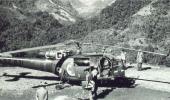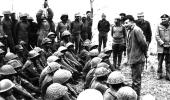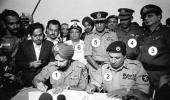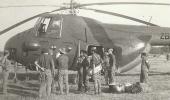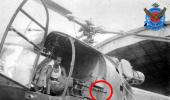'We flew all missions in the first part of the war at low levels; that is at 300 to 500 feet above the ground.'
'These sorties were no doubt stressful since the pilots and crew had to look out for birds and obstructions as well as enemy gunfire.'
Air Commodore Nitin Sathe continues his fascinating year-long series on the 1971 War, 50 Years On.
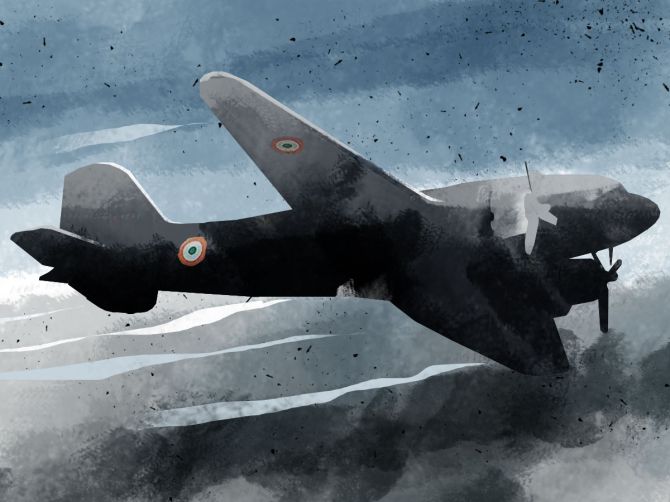
- Part 1: Meet War Hero 'Keen Kumar'
"I knew nothing about the 'Kilo' Flight till I was detailed to join them on December 1, 1971, along with Squadron Leader S K Chaudhary, a senior pilot and QFI (qualified flying instructor), flying into Dimapur (in Nagaland) where they were based," remembers Air Commodore Arun Dattraya Karandikar (retd).
"The raison d' etre for creating this unit was to give these pilots a sense of participation in the war to liberate East Pakistan from their Pakistani rulers," says Air Commodore Karandikar.
The aircraft Kandy Sir was allotted was the HJ-882.
It had nosed over the previous day during a full-power run by a technician and both propeller tips had got bent! The aircraft was declared serviceable after the propellers were changed and caution was given not to use maximum RPM (revolutions per minute).
"The HJ-882 was like my personal possession till December 16," Kandy Sir smiles.
"There were nine PAF (Pakistan air force) pilots, the senior-most being Squadron Leader Sultan Mahmud (who later became the chief of the Bangladesh air force). I remember a Flight Lieutenant Alam who had flown an F-86, another Flight Lieutenant Alam who was a C-130 pilot, a Captain Shahbuddin from a regional airline and one Sharafuddin.
"Sultan Mahmud and the fighter pilot Badrul Alam were trained on an Alouette (Chetak) helicopter by Squadron Leader C M Singla; the rest on Otter aircraft by Squadron Leader Ghoshal. Both aircraft were fitted with 30 mm rocket pods and a machine gun firing sideways in the rear -- for which the door had been removed on the left side -- operated by an airman crew."
There had been talk of equipping a Dakota in a similar fashion, but it was never done. Probably it would have taken a long time for the available pilots to build up the necessary skill levels. Also, none of the Bangladeshi pilots was trained to fly a Dakota at that time under the Kilo Flight banner.
However, during the earlier part of the year, two Bangladeshis were trained at Dimapur on a civil registered Dakota which was handed over to Bangladesh for use in their airline, the Bangla Biman.
The Dakota crashed in February 1972, killing Captain Shakeel and four others. Shakeel had been trained by Squadron Leader S K Chaudhary, who was flying with then Flying Officer Karandikar as part of the Kilo Force.
"The ex-PAF guys used to tell us tales of the unique privileges enjoyed by military officers in Pakistan.
"Apart from unbelievable salaries, unique privileges like duty-free import of whatever they wanted were the cause of some envy! Due to such privileges, they enjoyed the attention of celebrities and film stars and often were treated like them!
"I remember, during a visit to Chittagong (in Bangladesh) after the war, I was talking to an old mess orderly like we usually do, enquiring about his well-being. As soon as I asked him, the man burst into tears. He told me that no officer had ever spoken to him except for ordering him around."
AN-12s were not used in the Eastern theatre but Caribou aircraft were used to drop a few bombs over the Tezgaon airfield (Dhaka, Bangladesh) on one or two occasions, Air Commodore Karandikar remembers. "This was done at night after complete air superiority had been achieved."
AN-12s were used with very good results in the Western theatre for the Changa Manga forests (Punjab, Pakistan), the SUI gas plants (Balochistan, Pakistan) and to bomb the Skardu airfield (Gilgit-Batlistan, Pakistan).
Wing Commander V B Vasisht, the commanding officer, was awarded a Maha Vir Chakra and Flight Commander Squadron Leader Ahluwalia a Vir Chakra. A navigator, Squadron Leader P B Kalra, also got a Vir Chakra.
Operations during the war
"The monsoons came and went and so did the festival of Diwali. We kept waiting for the balloon to go up," he recalls.
Aggressive postures were being taken on both sides and little skirmishes kept the situation hot.
"On December 2, 1971, we moved bag and baggage to Kailashahar (Tripura, near the border), a small airstrip with almost no infrastructure."
Having landed after the usual low-level runs, they were met by the Air Observation Post pilots of the Indian Army who flew the vintage Auster aircraft and were tasked to direct artillery fire on to the enemy as our forces advanced.
"The space on the tarmac to manoeuvre the aircraft was minimal. And the space available for us to live was even worse!
"As per the pecking order, since I was the junior-most, I got to live in the passenger hall of the terminal building where a few rooms were occupied by the seniors.
"After rolling out my bed on the floor, I got some sleep. In the morning, I used to load up my little household onto my Dakota, not knowing where I would be by the end of the day. I practically lived in my flying overalls.
"The food was simple. Our only cook produced dal, roti and a vegetable dish from whatever was available locally. We ate the hot food happily, without cribbing.
"Later, well into the war, when the Chetak helicopter operated from our base, it would land in enemy territory and get us some good fish and other stuff to spice up our lives!"
In the evenings, when there was some breathing time, the pilots and other crew sat down together and listened to the radio to understand the larger picture.
Some of them had seen the war of 1965 and had stories to tell from that war too.
"From the '65 experience, we would often conjecture where all this fighting would lead to and what would be the endgame.
"As the war progressed and the situation became clearer, we were now sure that East Pakistan would soon be a separate nation... it was just a matter of time before we had a brand-new neighbour.
"The balloon finally went up on December 3 and we were quite excited to be the soldiers fighting for our nation."
The first attack into Bangladesh was spearheaded by the Chetak aircraft piloted by Sultan Mahmud and Alam, who attacked the oil storage tanks at Chittagong and set it aflame.
Simultaneously, the Otter aircraft piloted by the other Alam and Sharafuddin attacked the fuel depot at Narayanganj (now in central Bangladesh).
Group Captain Chandan Singh showed remarkable leadership qualities when he tasked the all-'Bangla' crew, who were new to these aircraft, to fire the first shots to win them their freedom.
On subsequent missions, the senior and more experienced Indian crew flew in these machines alongside the 'Bangla' pilots.
Air Commodore Karandikar had an interesting fact to narrate about the Otter mission.
"Originally, Chandan Singh had briefed the Otter pilots to attack the POL (petrol, oil and lubricants) dump at Dacca (then in East Pakistan). As the Otter was starting up for the sortie, Chandan Sir realised it would be too risky to send the aircraft to heavily defended Dacca and changed the target to Narayanganj. Do you know who went running to the aircraft to give this message? It was me!"
Maybe, the lives of the Otter pilots were saved that day due to this timely decision.
"From what I remember, both aircraft got lost while returning home in the pitch-dark night. Luckily, we had ATC controllers at Teliamura (in Khowai, Tripura) where the Chetak was recovered. The Otter landed at Kumbhigram (Assam) with just a few litres of fuel remaining!"
In the wee hours of the morning, Kandy Sir flew his Dakota from Kailashahar (in Tripura) to Kumbhigram, with essential oils and the ground crew to recover the plane so that it was ready to fight again.
Kandy Sir's Dakota was tasked with undertaking sorties on an as-required basis between Kailashahar, Kumbhigram and Dimapur.
"I also flew one troop insertion sortie into enemy territory at Shamshernagar (now in Bangladesh) on December 5. The Air OP pilots -- I think it was Captain Kriplani -- flying in the area reported heavy Pakistani shelling on that landing ground to prevent any further missions by the Dakota.
"We flew all missions in the first part of the war at low levels; that is at 300 to 500 feet above the ground. These sorties were no doubt stressful since the pilots and crew had to look out for birds and obstructions as well as enemy gunfire.
"Later on, once the Pakistani air force was decimated in the east, we flew at 5,000 feet. This was less stressful, to say the least! We were clear of enemy ground fire and navigation was also easy," says the ace pilot.
The Dakota carried all logistic support needed to keep the Kilo Flight aircraft fly-worthy as well as brought in the POL, rockets and ammunition for the guns.
Air Commodore Karandikar also flew a few 'propaganda' missions, which involved dropping leaflets over enemy territory.
Air Commodore Nitin Sathe retired from the Indian Air Force in February 2020 after a distinguished 35 year career.
The author of three bestsellers, you can read Air Commodore Sathe's contributions here.
Feature Presentation: Rajesh Alva/Rediff.com
